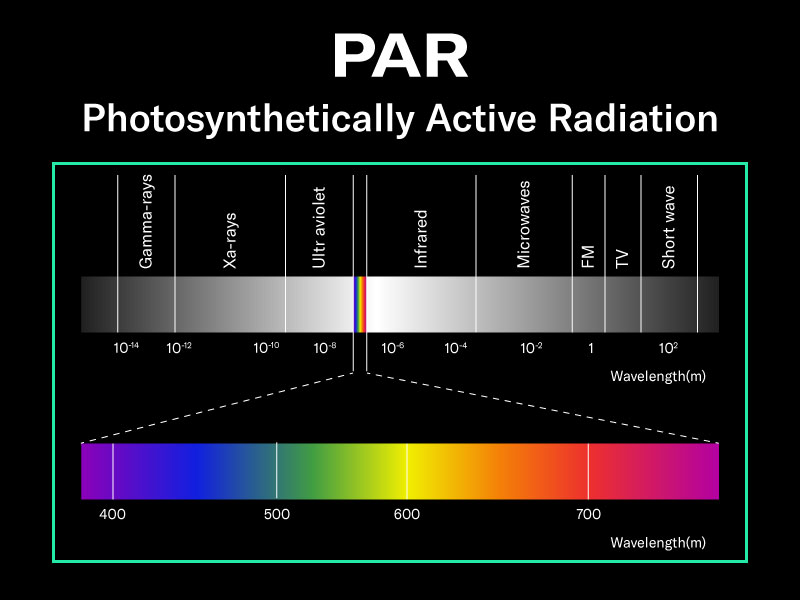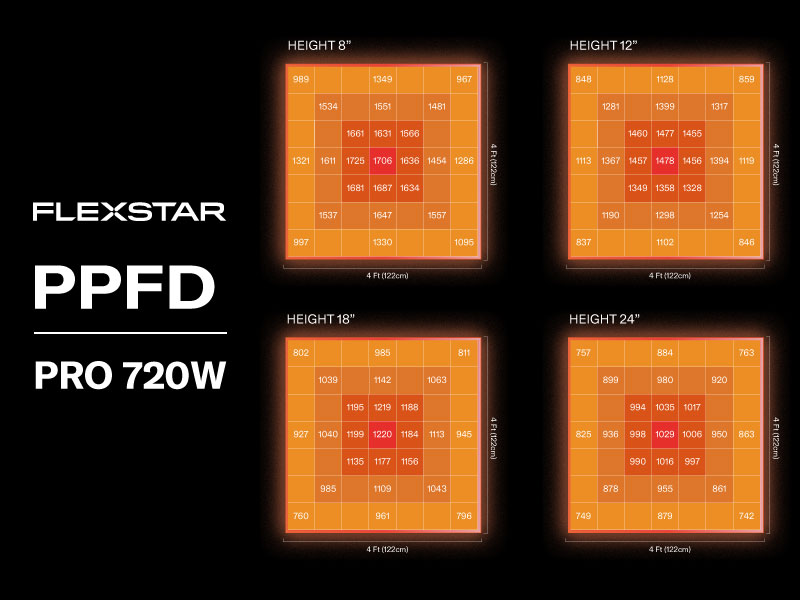Introduction
Lighting is a critical component of successful indoor growing, and understanding key metrics like PAR, PPF, PPFD, and PPE can be the difference between an average yield and an exceptional one. Growers often hear these terms thrown around, but what do they really mean, and how do they affect plant growth?
In this article, we’ll dive into these essential metrics and explain how each one plays a role in optimizing grow light performance.
1. What is PAR?
PAR (Photosynthetically Active Radiation) refers to the specific range of light (400-700 nm) that plants use for photosynthesis. It’s not a measure of light intensity, but rather the type of light that plants need to grow. When people refer to “PAR light,” they are talking about the wavelengths that contribute directly to plant photosynthesis.

Why is this important? Plants use different parts of the light spectrum to drive various growth processes. For example, blue light encourages vegetative growth, while red light supports flowering. Having a light source that delivers ample PAR is essential for healthy, robust plants.
2. Understanding PPF
What is PPF and Why It’s Important?
PPF measures the total amount of PAR light (measured in micromoles per second or µmol/s) emitted by a light source. Essentially, it quantifies how much usable light energy a grow light is putting out into the growing environment.
PPF is critical because it’s the total amount of light your fixture puts out. Higher PPF means more photons are available to your plants, which translates to faster growth and larger yields. Flexstar lights offer industry-leading PPF levels, ensuring your plants get the most light possible for photosynthesis.
3. Exploring PPFD (Photosynthetic Photon Flux Density)
3.1 What is PPFD and Why It’s Important?
PPFD measures the amount of PAR that actually reaches your plant’s canopy per second, expressed in micromoles per square meter per second (µmol/m²/s). Think of PPFD as the density of light your plants are getting, which directly impacts how much energy they can absorb and utilize for photosynthesis. Too little light and plants won’t grow as effectively. Too much light, and you risk light burn.
3.2 How to Calculate PPFD?
To calculate PPFD, you divide the total PPF by the light’s coverage area:
PPFD=PPF (µmol/s)÷Area (m²)
For example, if a light has a PPF of 1000 µmol/s and covers an area of 1.48 m² (a 4’x4′ tent), the PPFD would be:
PPFD=1000 µmol/s ÷ 1.48 m²=675.68 µmol/m²/s
This would be the average PPFD over the entire canopy area.
3.3 Optimize Light Height
Adjusting the height of your grow light affects PPFD. Lowering the light increases PPFD but may reduce uniformity and coverage area. Raising the light decreases PPFD, but improves uniformity and expands the coverage area. Fine-tune the height of your light fixture to ensure all plants receive the optimal PPFD for their growth stage.

4. Explaining PPE
What is PPE and Why It’s Important?
Photosynthetic Photon Efficacy (PPE) measures the energy efficiency of a grow light. It’s the amount of PAR light (in µmol) produced per joule of energy consumed (µmol/J). Higher PPE means that more light is being produced with less energy, leading to both lower electricity bills and a reduced environmental impact. Flexstar grow lights are designed to maximize PPE, ensuring you get more light for less energy.
How to Calculate PPE?
5. The Relationship Between PAR, PPF, PPFD, and PPE
These four metrics are interconnected. PAR defines the usable light spectrum, PPF measures the total light output, PPFD tells you how much of that light reaches your plants, and PPE indicates how efficiently that light is produced. By understanding how these metrics interact, you can optimize your lighting setup to improve plant health and yields.
6. PAR vs PPF vs PPFD vs PPE: Key Differences
Here’s a quick summary of how these metrics differ:
- PAR: The spectrum of light plants can use (400-700 nm).
- PPF: The total output of PAR light from the grow light.
- PPFD: The amount of PAR light reaching the plant canopy.
- PPE: The efficiency of converting electrical power into PAR light.
7. Choosing the Right Grow Light Based on Metrics
7.1 Evaluating Grow Lights Based on PAR, PPF, PPFD, and PPE
When selecting grow lights, it’s essential to balance these metrics. A light with high PPF but low PPFD may not provide sufficient light intensity to the plant canopy. A high PPE rating ensures that you’re not wasting energy, which is why Flexstar LED lights are engineered to excel in all these areas.
7.2 Flexstar: Leading in Light Efficiency
At Flexstar, we take pride in offering some of the most efficient and high-performing grow lights on the market. Our lights not only deliver industry-leading PPE, but they also ensure optimal PPFD at the canopy, leading to bigger yields and healthier plants.
Conclusion
Understanding the key metrics of PAR, PPF, PPFD, and PPE is essential for choosing the right grow light. By considering all of these factors, you can ensure that your plants receive the optimal light intensity and spectrum they need for superior growth and yield.
